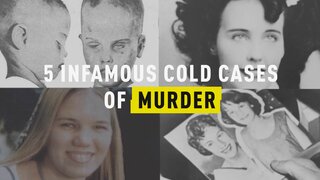Create a free profile to get unlimited access to exclusive videos, breaking news, sweepstakes, and more!
Dead Colorado Man Identified As Rapist-Murderer In 38-Year-Old Cold Case
The same forensic genealogy technology that helped identify the Golden State Killer suspect was used to pinpoint Donald Perea as the rapist and killer behind the 1981 death of 18-year-old Jeannie Moore.
On Aug. 30, 1981, the corpse of 18-year-old Jeannie Moore was discovered in a Denver mountain park. She had been brutally raped and killed, with an autopsy revealing Moore had suffered multiple blows to the head.
For nearly 40 years, the case went unsolved — until now. This week, Jefferson County authorities announced they had pinpointed Moore’s killer in the decades-old cold case.
Police said Donald Perea, a 54-year-old convicted rapist who died in 2012 due to health issues, had taken the young woman, sexually assaulted her, and eventually murdered her.
“Our goal then and now has been to bring justice to Jeannie and her family,” said Jefferson County Sheriff Jeff Shrader in a press release posted to Facebook.
“And while we would have preferred to place handcuffs on the suspect, we hope knowing who and where he is brings them some degree of closure.”
Detectives believe Perea killed Moore when he was 23 and out on bond related to another sexual assault case, according to CBS.
Moore’s family called the news "mind-blowing," but not necessarily closure.
“At least he’s gone. I’m sorry. I hate to say that about another human being but … I think he’s a monster,” said her sister Mickie Moore to CBS.
“To look back 38 years — and thousands and thousands of hours that other investigators had put into trying to solve this case — it’s a bittersweet thing for the family,” Jefferson County investigator Elias Alberti told Oxygen.com.
“They’re obviously happy that they have some sort of answers and closure to their sister’s death and murder,” he added. “But it’s also kind of bitter because it brings up things they’ve buried over the last 38 years.”
The cold case was solved largely in part to a relatively new forensic genealogical testing method that also helped nab the Golden State Killer suspect.
In their investigation, Jefferson County authorities implemented a new genealogical testing method through a partnership with Metro Denver Crime Stoppers and United Data Connect, a forensic science computing agency. The analysis revealed a match, tying DNA evidence from the scene of the crime to a close relative of Perea’s.
Investigators eventually determined “Perea as being 3.3 trillion times more likely than anyone else to have committed the murder.”
“Clearly there was no one else that it could have been but him,” former Denver District Attorney Mitch Morrissey and United Data Connect’s founder told Oxygen.com. “The only disappointment in this case was that he died before he could be held accountable for this murder."
The genealogical genetic method used, Morrisey said, analyzes crime scene forensics with family tree data publicly available on such sites as GEDMatch — a new strategy, he explained, which law enforcement typically didn’t use in the past.
Morrissey said that the case likely would have remained cold if not for the forensic genealogical testing method: "Because he was dead, we had to identify his offspring. He’s no longer around. The only way to solve this case, especially with the age of this case, was through DNA and through genetic genealogy.”
Alberti, the Jefferson County investigator, noted that while ancestry websites — and their technology — aren't a recent phenomenon, genealogical genetics are a new forensic tool for police.
“To take this technology that’s used to find ancestors, and family trees, and to take that technology and try to convert it into law enforcement use to close cases that are decades old is phenomenal,” Alberti said.































